Chang An-le (張安樂) arrives at the front of his offices impeccably dressed in one of his famous white, no-collar dress shirts. He immediately comes over, shakes my hand and apologizes as he has another appointment, and disappears with a retinue of men into a room.
The longer I wait, the more nervous I become — a rational response, perhaps, to a man who has a well-known reputation as a former boss for the Bamboo Union Gang (竹聯幫), a notorious triad. My anxiety is offset, somewhat, by the fact that I’ve come to discuss the China Unification Promotion Party (CUPP, 中華統一促進黨), a party he formed while on the run in China from Taiwanese authorities, a time when he is said to have grown close to high-level Chinese politicians. As I’m led past an oversized and macho statue of the God of War (Guan Gong, 關公) into a large office, I recall Chang’s scathing rhetoric against Sunflower movement supporters, and his bombastic appearance (“You are all fucking offspring of China, but do not deserve to be Chinese.”) at the April 1 counter-protest in support of the government’s unpopular trade pact with China.
In person, though, Chang, who is commonly known as “White Wolf”, is the picture of rational and contemplative civility. Since taking on the new and intriguing role as the savior of the Republic of China (ROC) from democratic Taiwan, he has been attracting a group of unexpected supporters — young voters.
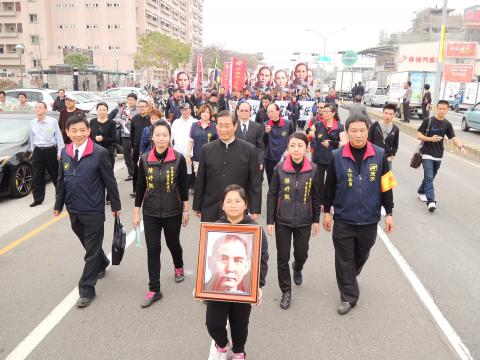
Photo: Wang Chun-chung
TALKING POINTS
Chang echoes the Chinese Communist Party’s (CCP) unification rhetoric when asked about his plans for the nine-in-one elections on Nov. 29. He says his first task is to turn the party’s slogan “one country, two systems is mutual respect, peaceful reunification is sharing prosperity” into palpable policies to attract new voters.
“The only reason people are afraid of unification is because they don’t understand it. If you explain to them that unification brings stability, prosperity and dignity, than they can accept it,” Chang says.
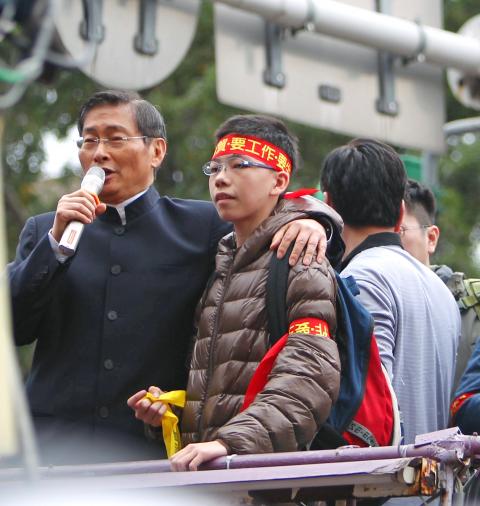
Photo: Wang Chun-chieh
The CUPP promotes immediate talks for Taiwan and China to unify under a one-country, two-systems framework. Chang’s party is actively promoting Taiwan’s historical namesake as the ROC, and cultural connections with China in order to push his party’s perspective that unification is a historical eventuality.
But Chang may already be too late to make his mark. Support for both eventual and immediate unification has continued to plummet to rock-bottom levels among the Taiwanese public. His proposal appears more pie in the sky, than a surefire vote grabber in this month’s nine-in-one elections.
Chang’s strategy has already borne fruit, attracting a handful of young recruits who subscribe to a doomsday narrative that Taiwan is sliding towards economic and political decline. Much like Chang — speaking almost word for word — these young supporters say Taiwanese are in “denial” of their Chinese roots.
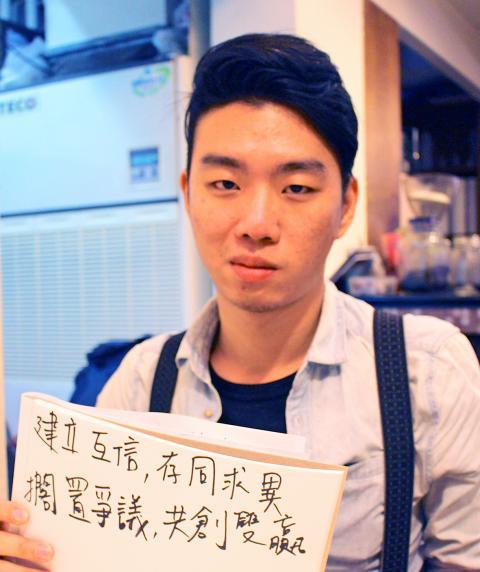
Photo: Aaron Wytze Wilson
But it’s often unclear what they mean by Chinese roots. Like many pro-China politicians, they subscribe to a positive view of Chinese cultural history that for them Taiwan is unambiguously apart of. But the danger of historic-cultural narratives linking Taiwan and China is their propensity for neglecting Taiwanese the freedom of choice in deciding their future.
This leads to all manner of blanket statements about Taiwan’s undeniable connection to China in order to avoid inconvenient truths about Taiwan carving out its own path to democracy.
“Young people in Taiwan have all forgotten their history. Totally forgotten it,” Chang says.
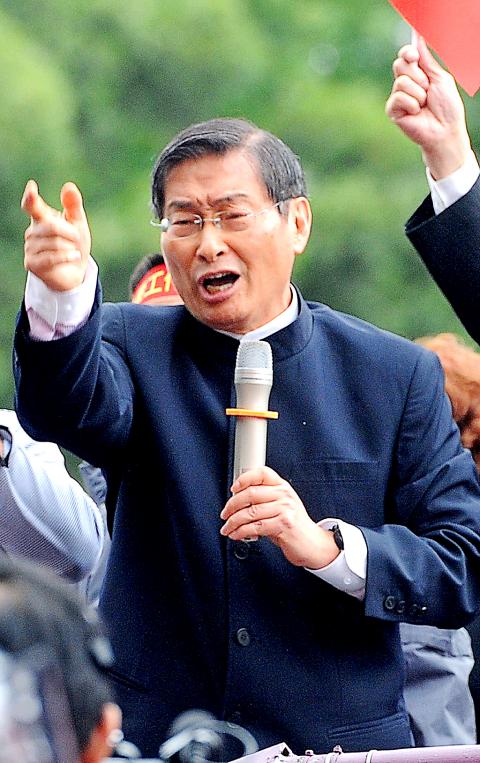
Photo: Wang Min-wei
Of course, Chang means that Taiwanese, particularly those under 40, have largely turned their back on China as being the center of the country’s historical narrative. But Chang and his CUPP intend to change that by creating events that help “educate” young people about the importance of holidays like Retrocession Day, while showing that Taiwanese were treated fairly with the arrival of the “liberating” Chinese Nationalist Party (KMT) after World War II.
“Young Taiwanese need to understand that China doesn’t exclusively belong to the CCP. It belongs to all of us. China is the only place that is opened especially for us, and we say ‘no’ because of populism,” Chang says.
“Populism” is the all-encompassing euphemism Chang uses to refer to Sunflower movement activities, a strange inversion by someone who is long on rhetoric and short on concrete policies.
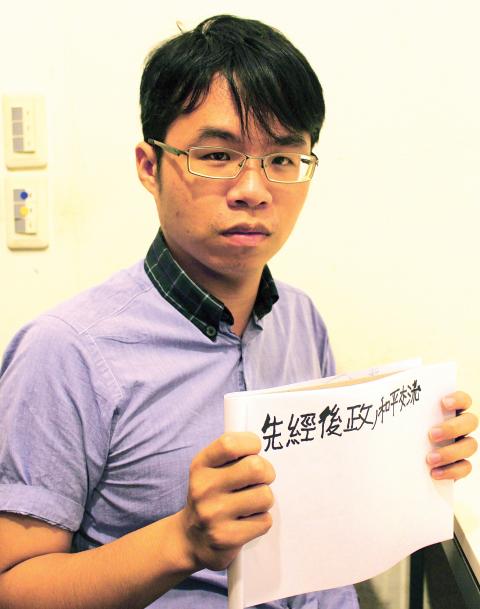
Photo: Aaron Wytze Wilson
Yet if the students responsible for the Sunflower movement (and the Wild Strawberry and Wild Lily movements before it) shows anything, it is the keen awareness that Taiwanese, especially Taiwanese under the age of 40, have toward their history, and the need to refine the current system of governance to further deepen its democracy.
Indeed, Chang seems incapable of recognizing modern Taiwan — perhaps because he wasn’t around to see its democratic transition. He moved to the US in the late 1970s, served time there for drug trafficking in the 1980s and was then on the run from Taiwanese prosecutors for 17 years before returning to Taiwan last year. Remarkably, he hasn’t had to account for his crimes.
REACTIONARY YOUTH?
Tung Li-wen (董立文), a professor at Central Police University’s Public Security Department, who has studied small, pro-unification parties, says the CUPP’s goal revolves less around short-term electoral success, and more around increasing the party’s prominence in the public eye, and once again open the discussion about unification among the Taiwanese public.
“They want unification to become as openly discussed as independence is in Taiwanese society,” Tung says.
To bring this about, Chang has been seeking out a younger generation of politically motivated students who agree with Chang’s values. I meet Chang Kai-lun (張凱掄) and Hsia Yi-ching (夏義清), both in their twenties, during my visit to CUPP headquarters, and later at a coffee shop to further understand their support for the CUPP. But both mainly parrot their leader’s maxims.
Chang Kai-lun and Hsia take turns answering my questions over coffee and salad. I start by asking why they chose to join the CUPP and not other pro-unification parties like the KMT or the New Party.
“If I was looking for power, I would join the KMT. But I’m only a student, so my thinking isn’t that developed. I’m young, and I should stand up for what I believe, so I’ve chosen the CUPP,” Chang Kai-lun says, adding that the KMT and the New Party still want to get votes, so they drop the “unpopular” topic of unification on the wayside.
When asked why Hsia supports the CUPP, he says that China will not let Taiwan become independent, and Taiwan doesn’t dare declare independence. “I’m just supporting the most likely end for Taiwan, which is unification,” says Hsia.
But both Hsia and Chang Kai-lun avoid directly mentioning Taiwan in the context of its democracy, saying unification is inevitable because of past cultural and historical interactions with China. Throughout my interviews with Chang An-le, Chang Kai-lun and Hsia, the theme that “Taiwan must play by China’s rules (particularly one country, two systems) for it to have leverage in the future” continually arises.
If polls over the past decade are any indication, however, it’s a proposition that seems increasingly unrealistic. Even protesters in Hong Kong chafe at Beijing’s control over their own politics.
The views of Chang Kai-lun and Hsia rarely differ from Chang An-le’s. At one point, Chang Kai-lun says that Taiwanese have always been Chinese. For him, being “Taiwanese” is no different than being from Henan.
If the recruitment of Chang Kai-lun and Hsia is any indication, Chang An-le’s message has saliency among young people who are pessimistic and skeptical about Taiwan’s political future. But questions remain unanswered about CUPP support among young people. Do Chang Kai-lun and Hsia represent a minuscule number in support of unification, or a new tide of young people sympathetic to Chang An-le’s ideas?
Polls by Chengchi University taken in July show that only 8 percent of respondents support eventual unification with China, and 1.4 percent support immediate unification. The polls indicate that those identifying themselves as Taiwanese has consistently grown over the past two decades. Moreover, past pro-unification platforms by the New Party have met with utter failure on Election Day. The New Party’s 2012 campaign slogan, “face up to unification” (面對統一), left them with a total of 1.35 percent of the popular vote.
But in contrast to the CUPP, the New Party is at least a well-oiled election machine, with some big name candidates like Yang Shih-kuang (楊世光), a controversial TV host on EBC Financial News Channel. CUPP has no big name candidates for this year’s nine-in-one, and Chang has ruled out running himself, stating he will concentrate his attention on the 2016 elections.
Chang said that he considered having 23-year-old Chang Kai-lun run for Greater Tainan mayor, though more as a protest candidate as mayoral hopefuls must be at least 30 years old. The goal isn’t to have CUPP candidates elected, Chang An-le says, but to raise their profile among the Taiwanese public.
THE LONG GAME
Tung says the CUPP is focused on a long-term game that puts unification back on the table to be openly discussed among the public. “There’s always 2016, 2020. They’re not going to give up if they don’t get many votes this election,” he says.
In addition, Tung says that the CUPP can draw on massive financial support from China. The CCP has close ties to many of Taiwan’s pro-unification parties, and can even indirectly fund political parties like the CUPP through shell companies. It is incredibly difficult to track where these small parties get their funds, Tung says.
Tung added that the CCP realized after the 2004 election that a tiny margin of votes can decide Taiwan’s presidential elections.
“Even with a small number of new, young voters who support unification, they can control the crucial votes that decide the election,” Tung says.
If Tung is correct, Chang only needs to attract a small amount of new supporters to irreversibly affect Taiwan’s future.
— Additional reporting by Noah Buchan

In the March 9 edition of the Taipei Times a piece by Ninon Godefroy ran with the headine “The quiet, gentle rhythm of Taiwan.” It started with the line “Taiwan is a small, humble place. There is no Eiffel Tower, no pyramids — no singular attraction that draws the world’s attention.” I laughed out loud at that. This was out of no disrespect for the author or the piece, which made some interesting analogies and good points about how both Din Tai Fung’s and Taiwan Semiconductor Manufacturing Co’s (TSMC, 台積電) meticulous attention to detail and quality are not quite up to

April 21 to April 27 Hsieh Er’s (謝娥) political fortunes were rising fast after she got out of jail and joined the Chinese Nationalist Party (KMT) in December 1945. Not only did she hold key positions in various committees, she was elected the only woman on the Taipei City Council and headed to Nanjing in 1946 as the sole Taiwanese female representative to the National Constituent Assembly. With the support of first lady Soong May-ling (宋美齡), she started the Taipei Women’s Association and Taiwan Provincial Women’s Association, where she

Chinese Nationalist Party (KMT) Chairman Eric Chu (朱立倫) hatched a bold plan to charge forward and seize the initiative when he held a protest in front of the Taipei City Prosecutors’ Office. Though risky, because illegal, its success would help tackle at least six problems facing both himself and the KMT. What he did not see coming was Taipei Mayor Chiang Wan-an (將萬安) tripping him up out of the gate. In spite of Chu being the most consequential and successful KMT chairman since the early 2010s — arguably saving the party from financial ruin and restoring its electoral viability —

It is one of the more remarkable facts of Taiwan history that it was never occupied or claimed by any of the numerous kingdoms of southern China — Han or otherwise — that lay just across the water from it. None of their brilliant ministers ever discovered that Taiwan was a “core interest” of the state whose annexation was “inevitable.” As Paul Kua notes in an excellent monograph laying out how the Portuguese gave Taiwan the name “Formosa,” the first Europeans to express an interest in occupying Taiwan were the Spanish. Tonio Andrade in his seminal work, How Taiwan Became Chinese,